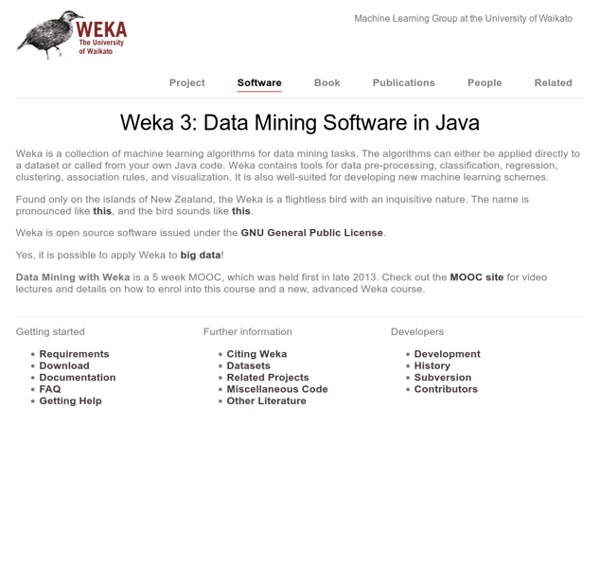



COC131 Data Mining, Tuotorials Weka "The overall goal of our project is to build a state-of-the-art facility for developing machine learning (ML) techniques and to apply them to real-world data mining problems. Our team has incorporated several standard ML techniques into a software "workbench" called WEKA, for Waikato Environment for Knowledge Analysis. Tutorial 01 (13/02/09) Get the old faithful data-set (.csv) here Get the tutorial 01 exercises here Get the tutorial 01 solutions here Statistics revision for Tutorial 01 here Tutorial 02 (20/02/09) Get the iris data-set (.arff) here Get the tutorial 02 exercises here Tutorial 03 (27/02/09) Get the tutorial 03 exercises here Tutorial 04 (06/03/09) Tutorial 03 exercises and clarification of any issues from earlier tutorials Tutorial 05 (13/03/09) Get the tutorial 04 exercises here Tutorial 06 (20/03/09) Get the flags data-set (.arff) here Get the whole euro data-set (.arff) here Get the tutorial 05 exercises here Tutorial 07 (27/03/09) Tutorial 08 (24/04/09) Coursework
Healthcare Reform May Not Improve Medical Bills A healthcare reform study in Massachusetts reported more people covered under insurance did not improve medical debts for them. Tuesday the American Journal of Medicine published these findings which looked at Massachusetts healthcare reform,modeled after President Barack Obamas national plan that was passed last year. Advocators for the national healthcare reform claimed it would reduce medical bankruptcy. "These data suggest that reducing medical bankruptcy rates in the United States will require substantially improved -- not just expanded -- insurance," authors wrote. Researchers took a random sample of Massachusetts bankruptcy filers in July 2009 and sent surveys to 500 households. The Massachusetts healthcare reform was implemented in 2008,so they compared their data to 2007 information. Medical bills were still 52.9 percent of all bankruptcies in the state, although the percent was slightly down. "We need to reduce limits on deductibles and out-of-pocket costs," said Dr.
The R Project for Statistical Computing Octave GNU Octave is a high-level interpreted language, primarily intended for numerical computations. It provides capabilities for the numerical solution of linear and nonlinear problems, and for performing other numerical experiments. It also provides extensive graphics capabilities for data visualization and manipulation. Octave is distributed under the terms of the GNU General Public License. Version 4.0.0 has been released and is now available for download. An official Windows binary installer is also available from A list of important user-visible changes is availble at by selecting the Release Notes item in the News menu of the GUI, or by typing news at the Octave command prompt. Thanks to the many people who contributed to this release! Implementation of k-means Clustering - Edureka In this blog, you will understand what is K-means clustering and how it can be implemented on the criminal data collected in various US states. The data contains crimes committed like: assault, murder, and rape in arrests per 100,000 residents in each of the 50 US states in 1973. Along with analyzing the data you will also learn about: Finding the optimal number of clusters.Minimizing distortionCreating and analyzing the elbow curve.Understanding the mechanism of k-means algorithm. Let us start with the analysis. The data looks as: Click on the image to download this dataset Need this dataset? First let’s prepare the data for the analysis. > crime0 <- na.omit(USArrests) > crime <- data.matrix (crime0) > str(crime) num [1:50, 1:4] 13.2 10 8.1 8.8 9 7.9 3.3 5.9 15.4 17.4 ... - attr(*, "dimnames")=List of 2 ..$ : chr [1:50] "Alabama" "Alaska" "Arizona" "Arkansas" ... ..$ : chr [1:4] "Murder" "Assault" "UrbanPop" "Rape" Let us take the number of clusters to be 5. Analyzing the Clustering :
Weka---Machine Learning Software in Java | Free software downloads Home - SCaVis Freedom to choose a programming language. Freedom to choose an operating system. Freedom to share your code. Supported programming languages SCaVis can be used with several scripting languages for the Java platform, such as BeanShell, Jython (the Python programming language), Groovy and JRuby (Ruby programming language). Supported platforms SCaVis runs on Windows, Linux, Mac and Android operating systems. SCaVis is a successor of the popular jHepWork package which has been under intensive development since 2005. Data Mining Algorithms In R In general terms, Data Mining comprises techniques and algorithms, for determining interesting patterns from large datasets. There are currently hundreds (or even more) algorithms that perform tasks such as frequent pattern mining, clustering, and classification, among others. Understanding how these algorithms work and how to use them effectively is a continuous challenge faced by data mining analysts, researchers, and practitioners, in particular because the algorithm behavior and patterns it provides may change significantly as a function of its parameters. In practice, most of the data mining literature is too abstract regarding the actual use of the algorithms and parameter tuning is usually a frustrating task. On the other hand, there is a large number of implementations available, such as those in the R project, but their documentation focus mainly on implementation details without providing a good discussion about parameter-related trade-offs associated with each of them.
A Guide to Deep Learning by YerevaNN When you are comfortable with the prerequisites, we suggest four options for studying deep learning. Choose any of them or any combination of them. The number of stars indicates the difficulty. Hugo Larochelle's video course on YouTube. There are many software frameworks that provide necessary functions, classes and modules for machine learning and for deep learning in particular. Jupyter notebooks are a convenient way to play with Python code.
GGobi data visualization system. Togaware: One Page R: A Survival Guide to Data Science with R